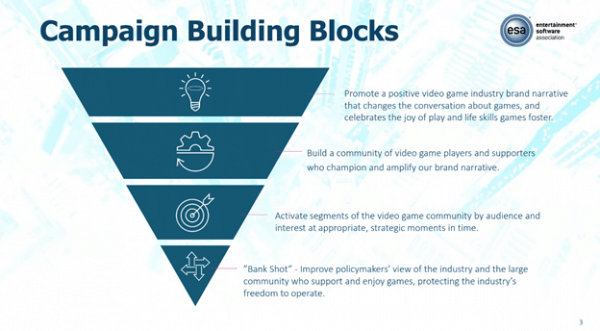Turning a negative perception issue into an opportunity
How the Entertainment Software Association’s “Game Generation” campaign helped the gaming industry shift the public narrative around video games.

Acting as the voice and advocate for the U.S. video game industry, the Entertainment Software Association represents a sector that generates over $41.5 billion in revenue each year domestically—outpacing even music sales and movie box office.
With over three billion gamers worldwide, the industry connects audiences across cultures, ages and gender in the fastest growing segment of entertainment. In the U.S. alone, there are over 214 million video game players. Sixty-four percent of adults and 70 percent of children under 18 play video games. Women and girls make up about half (41 percent) of players. Nearly 80 percent of all players are 18 or older.
But the video game industry also has its detractors. There are concerns about addiction. Parents worry about excessive screen time for kids and the violence depicted in many games. The World Health Organization even compared video games to other forms of addiction.
The Entertainment Software Association sensed it needed to counter the narrative and underscore the positive impact of video games that gamers worldwide already knew. “We were spending great amounts of time playing ‘whack-a-mole’, trying to react to these issues as they came up,” says Andrew Bowins, the association’s SVP of communications and public affairs.
Bowins’ team knew it was time to reassert a positive narrative around gaming, and that a proactive, industry-wide branding campaign was needed. It partnered in February with Ketchum Public Relations to launch “Game Generation,” which sought to empower and equip video-game supporters to defend gaming, challenge common assumptions, and ultimately influence public perception and policy decisions.
The team’s first step was to clearly articulate the narrative it wanted to share: interactive entertainment has a positive impact on people, culture and the economy. From there, Bowins’ team was careful to define a clear hierarchy of goals that would keep the messaging precise and intentional. “We didn’t want to just push a bunch of content out there and hope for the best,” he says.
The building blocks for the campaign included four objectives.
- To promote a positive narrative.
- To build and strengthen the community.
- To activate the community at crucial times.
- To improve policymakers’ perceptions about the industry.

Key audiences that the association wanted to reach included workers and developers in the industry, digital-savvy adults with a familiarity with interactive entertainment and dedicated self-described “gamers” and policy makers.
The Game Generation team was also careful to listen to those audiences before they spoke. Extensive testing and auditing was done to see which messages would resonate. The team found that its previous focus on economic factors was obscuring what was most important to audiences—the joy they found from video games.
This concept of “the joy of play” would become the overarching theme in the Game Generation campaign. Messaging pillars included how video games promote community, inclusivity and inspiration. The team wanted to define and showcase the community of video game players that already existed—and remind policymakers that during an election year, they were a key demographic to consider.
A consistent voice and visual brand was critical to the campaign’s success. The tagline “What can play do for you?” became a recognizable slogan that audiences came to recall over time. The team also created a short trailer that captured the voice, tone, feel and look of the campaign. This simple but articulate asset was critical to earning buy-in from industry leaders. “Often, less is more when selling a campaign like this,” Bowins says.
His team kicked off the campaign with a focus on earned media—they knew they needed to create newsworthy moments. They held events with policymakers and influencers in Washington, D.C., and embarked on a media tour to bring key figures into the conversation in its early days.
The next step was to amplify this buzz using digital channels and strategies. Display ads were placed within negative stories about gaming, helping to offer a counter perspective. Targeted social media ads were run too, which required a lot of keyword research and A/B testing, Bowins says. “You need to carefully consider how you’re using these digital marketing techniques and adapt them for the art of communications—resist the urge to be a content polluter,” he adds.
A digital hub was created where supporters could share their stories about what video games meant to them—this became an important source of content for the campaign. The site also allowed supporters to directly reach out to policymakers and access information that empowered them to serve as advocates.
The results? The campaign’s content engaged over 400 million people, and several thousand signed up for the digital hub independently. National press coverage helped connect with key policymakers and arm them with accurate information for decision-making.
This proactive approach also prepared the industry for the volatile and uncertain environment posed by the COVID-19 pandemic. With stay-at-home orders in place around the world, the conversation around video games began to organically shift, as many recognized their value in connecting people virtually. Even the World Health Organization, who had previously been a detractor, acknowledged the importance of games in fostering social connection and offering a mental reprieve from the stress of the pandemic.
With a strong brand already in place, the Entertainment Software Association was able to easily build on this momentum and contribute to these conversations in a way that wasn’t opportunistic or reactive. In fact, the need to manage reputation risk resulted in a campaign that gave the industry a unified voice and a showcase to celebrate the power and impact of video games. It became the foundation for the association’s ongoing approach to communications and public affairs.
“We moved away from a deli-counter approach to communications and embraced a framework that allow for proactive and unified storytelling,” Bowins adds. “It was in this framework that we moved from a bunch of amazing tactics to a well-defined strategy and program that helped us during good times and bad.”
Andrew Bowins shared this eye-opening case study during a recent Crisis Leadership Network member call—a new resource from Ragan providing guidance to communicators before, during and after times of crisis.








Love is wonderful but sometimes self-love isn’t.
This superb PR team had the good sense to “do extensive testing and auditing to see which messages would resonate.” Good!
The team “found that its previous focus on economic factors was obscuring what was most important to audiences.” Excellent! This avoids wasting effort on what doesn’t work well.
Then they came up with “building blocks for the campaign” that included four objectives enunciated in the piece above. Look at them.
These are not as excellent because look at the problem and what more could have been done about it.
THE PR PROBLEM this savvy PR team identified: “Concerns about addiction. Parents worry about excessive screen time for kids.”
WHAT COULD HAVE BEEN DONE in addition to supporting the four objectives: Show how parents can use gaming enjoyment to BENEFIT kids in two ways.
.1. Encourage kids to harness their WILL TO WIN.
.2. Encourage kids to look, as gaming teaches them to look, for WAYS TO WIN.
Gaming can be not just okay but beneficial for kids, and parental guidance can help make this happen. The four objectives of the association are not just okay and good but can be even more successful. Parents can be encouraged to use the lessons of gaming—(a) enjoy winning and (b) enjoy finding WAYS to win—to help their kids do well at school and at life.
The $41.5 billion that the industry gets now could become $81.5 billion. The public has the money and a good case can be made for the benefits of gaming. Perhaps these ideas are already included in supporting the first objective.